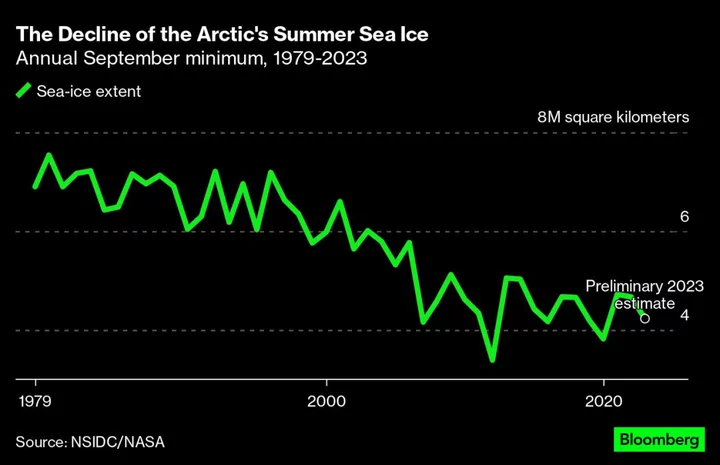Polar bears may be struggling to nourish their young as melting sea ice forces some populations to fast for longer periods, according to new research.
The bears — long held up as icons of the climate crisis — live only in the Arctic, around the North Pole and in northern parts of Canada, Alaska, Russia, Greenland and Norway. Their preferred habitat is the sea ice that covers Arctic waters for most of the year. When mother polar bears are forced onto land, as sometimes happens during the summer months, they struggle to access nourishing food and the quantity and quality of the milk they produce for their cubs declines, according to a paper that will be published Thursday in the journal Marine Ecology Progress Series.
The study, conducted by researchers at the University of Toronto, the US Geological Survey and Polar Bears International, analyzed milk samples collected from polar bears in Western Hudson Bay, Canada, between 1989 and 1994. After just three months on land, the likelihood of a mother continuing to produce milk for a cub born that year dropped 53%. For those bears that did continue to lactate, the energy content of the milk was also halved, or cut by three-quarters if they were nursing two cubs. Less milk, or poorer quality milk, lowers the chance of a cub surviving.
The study may help explain what has happened to polar bears in Western Hudson Bay since the milk samples were first collected. Between the early 1980s and 2021, the area’s polar bear population fell 50% to just 600 bears. Over roughly the same period, the amount of time the animals were forced to spend on land each summer lengthened by almost a month, as sea ice melted earlier and refroze later.
“The longer they’re on land, the more the mums prioritize their own survival at the expense of providing energy to their cubs,” said Louise Archer, one of the paper’s authors. “That can have a knock-on impact on the cubs themselves and ultimately impact the population.”
In the 1980s, it was common for bears in Western Hudson Bay to have litters of three cubs at a time, but this has become increasingly rare, Archer said. Females also now tend to stay with their cubs for about two-and-a-half years, a year longer than they used to, meaning they can’t reproduce again as quickly. Both of these trends affect population size and suggest the mothers are becoming “energetically challenged” by the longer time on land.
Polar bears’ lives are dominated by the cycles of sea ice, with most of their fat stores amassed during the fall and winter when they can travel over ice to catch seals that surface. When the ice breaks up in early summer, they move onto land, where other animal food sources, like caribou, require too much energy to catch for the amount of nourishment they would provide. This summer, the extent of Arctic sea ice was the sixth lowest ever recorded, and scientists believe the Arctic could experience whole summer months without any sea ice as soon as the 2030s due to global warming.
Read More: The Arctic Will Have Ice-Free Summers as Soon as the 2030s
Of the world’s 19 known polar bear populations, most live in extremely remote areas and are not well studied by scientists. But none appear to be increasing over the long term and the three populations that have been most closely studied are shrinking, Archer said. In all three locations, sea ice is declining and the bears are spending longer on land. “So those three are kind of the indicator populations, as what we might expect in other parts of the Arctic if we continue seeing sea ice decline,” Archer said.
The study’s findings are consistent with other research suggesting healthy polar bear populations won’t be able to survive long-term in areas where sea ice disappears for much of the year, said Elisabeth Kruger, manager of Arctic wildlife at the World Wildlife Fund. “Even if we moderately reduce our greenhouse gas emissions, local extinctions of polar bears from some parts of the Arctic are likely within this century,” she said, “and if we fail to reduce our emissions, we may lose all but a few high-Arctic populations.”
The polar bear has long been a poster child for the consequences of climate change. In 1993, biologists Ian Stirling and Andrew Derocher co-authored a paper titled “Possible Impacts of Climatic Warming on Polar Bears,” marking the beginning of a link that captured the public’s imagination. In the 30 years since, photos of lonely-looking bears adrift on tiny islands of ice as well as of emaciated bears and drowning bears have gone viral. While some have been debunked as misleading or even fake, the bears’ dependence on fast-disappearing sea ice has been been well established and the thick-furred giant carnivores have come to epitomize the tragedy of a fast-warming Arctic.
This latest paper adds to a growing understanding of how sea ice loss affects polar bears and their prey in multiple ways, said Stirling, now a research scientist emeritus with Environment and Climate Change Canada and an adjunct professor at the University of Alberta.
“These are things that take a long time to be able to measure and document,” he said. “You don’t get start to get the really big payoffs until you’ve been there a long time.”
While they are “incredibly charismatic” animals, Kruger noted, it’s important to remember that “what helps polar bears helps people.” Saving the sea ice, she said, “is not just about polar bears, it’s about all of us.”

